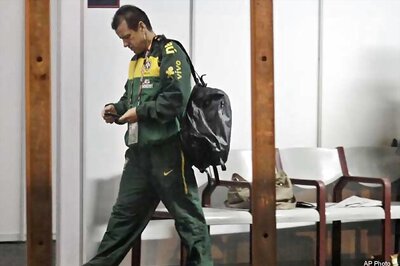
views
With hopes high that search crews are zeroing in on the missing Malaysian jetliner's crash site, ships and planes hunting for the aircraft intensified their efforts Thursday after equipment picked up sounds consistent with a plane's black box in the deep waters of the Indian Ocean.
Thursday's search zone was the smallest yet in the monthlong hunt for Flight 370, and comes a day after the Australian official in charge of the search expressed hope that crews were closing in on the "final resting place" of the vanished jet.
Angus Houston, who is coordinating the search off Australia's west coast, said Wednesday that equipment on the Australian vessel Ocean Shield had picked up two underwater sounds Tuesday, and an analysis of two other sounds detected in the same general area on Saturday showed they were consistent with a plane's flight recorders, or "black boxes."
"I'm now optimistic that we will find the aircraft, or what is left of the aircraft, in the not-too-distant future," Houston said Wednesday.
No further sounds had been picked up overnight, Houston's search coordination center said Thursday. But the Ocean Shield was continuing its hunt, slowly dragging a US navy pinger locator through the ocean's depths, hoping to find the signal again and get a more specific fix on its location.
Thursday's search area, about 2,300 kilometers (1,400 miles) northwest of Perth, was narrowed to 57,900 square kilometers (22,300 square miles), where 14 planes and 13 ships were looking for floating debris.
Within this zone is a smaller 1,300 square kilometer (500 square mile) patch of the ocean floor where the Ocean Shield is trying to re-locate the underwater sounds it heard earlier.
A "large number of objects" had been spotted by crews combing the area for floating debris on Wednesday, but the few that had been retrieved by search vessels were not believed to be related to the missing plane, the search coordination center said.
Crews hunting for floating debris have already looked in the area they were crisscrossing on Thursday, but were moving in tighter patterns, now that the search zone has been narrowed to about a quarter the size it was a few days ago, Houston said.
Finding the flight data and cockpit voice recorders soon is important because their locator beacons have a battery life of about a month, and Tuesday marked one month since Flight 370 vanished en route from Kuala Lumpur, Malaysia, to Beijing with 239 people aboard.
The plane veered off-course for an unknown reason, with officials saying that satellite data indicates it went down in the southern Indian Ocean. The black boxes could help solve that mystery.
But if the batteries fail before the recorders are located, finding them in such deep water - about 4,500 meters, or 15,000 feet - would be difficult, if not impossible.
A data analysis of the signals heard Saturday 1,645 kilometers (1,020 miles) northwest of Perth indicated they were distinct, man-made and pulsed consistently - indicating they are coming from an aircraft's black box, Houston said.
An Australian government briefing document circulated among international agencies involved in the search on Thursday said it was likely that the acoustic pingers would continue to transmit at decreasing strength for up to 10 more days, depending on conditions.
Once there is no hope left of the Ocean Shield's equipment picking up any more sounds, an unmanned submarine will be sent into the depths to create a sonar map of a potential debris field on the seabed. The search coordination center confirmed on Thursday that searchers had not yet deployed the sub.
The Bluefin 21 sub takes six times longer to cover the same area as the pinger locator, and it would take the vehicle about six weeks to two months to canvass the underwater search zone, which is about the size of Los Angeles. That's why the acoustic equipment is still being used to hone in on a more precise location, US Navy Capt. Mark Matthews said.
Complicating matters, however, is the depth of the seafloor in the search area. The pings are emanating from 4,500 meters below the surface - which is the deepest the Bluefin 21 can dive.
"It'll be pretty close to its operating limit. It's got a safety margin of error and if they think it's warranted, then they push it a little bit," said Stefan Williams, a professor of marine robotics at Sydney University.
The search coordination center did not immediately respond to a question about its contingency plans should the black box be too deep for the sub to reach. But Williams suspects if that happens, the search will be delayed while an underwater vehicle rated to 6,000 meters (19,700 feet) was dismantled and air freighted from Europe, the US or perhaps Japan.
Williams said colleagues at the Woods Hole Oceanographic Institution in Massachusetts had autonomous and remotely operated underwater vehicles that will dive to 11 kilometers (36,100 feet), although they might not be equipped for such a search.
Underwater vessels rated to 6,500 meters (21,300 feet) could search the sea bed of more than 90 percent of the world's oceans, Williams said.
"There's not that much of it deeper than six and a half kilometers," he said.
Williams said it was unlikely that the wreck had fallen into the narrow Diamantina trench, which is about 5,800 meters (19,000 feet) deep, since sounds emanating from that depth would probably not have been detected by the pinger locator.
Meanwhile, the Australian navy dropped buoys by parachute in a pattern near where the signals were last heard.
Royal Australian Navy Commodore Peter Leavy said each buoy will dangle a hydrophone listening device about 300 meters (1,000 feet) below the surface. The hope, he said, is the buoys will help better pinpoint the signals.



















Comments
0 comment